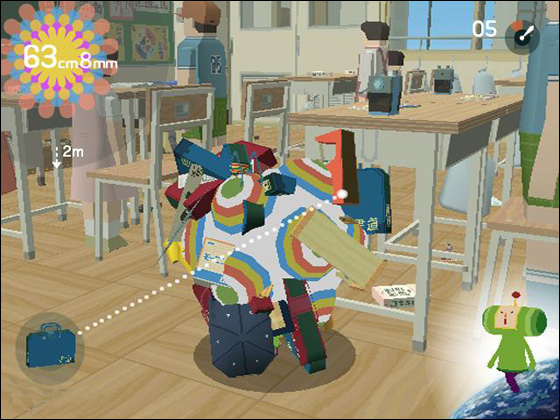Play Impressions (25/2/10)
February 25th, 2010

Geeze, it’s been roughly 6 months since the last Play Impressions article. You can hardly call it a regular feature anymore, can you?
Sonic Rush
The quality of a 2D Sonic game hinges largely on the level design. Controllability and presentation tend not to really matter since the games follow an established template. Level design, on the other hand, is a huge point of contention. The main reason why we still crawl back to our Megadrives (/console of choice) to play the original Sonic the Hedgehog is because the levels are so richly layered with branching paths. Each level was seemingly intended to be enjoyed multiple times over, offering players a great deal of replayability. Furthermore, Sega motivated players to explore by 1) distinguishing alternative paths from the main route and providing a fair window of opportunity/sufficient scaffolding to reach them 2) occasionally slowing down the pace (in cramped areas, for example), giving players room to mine for secrets. Exploration gave Sonic shape and dimension, and is ultimately what propelled him up with the likes of the Mario series.
Sonic Rush is perhaps closer to a series reboot than anything else, since it largely forgoes the exploration elements in replace of high speed spills and thrills. Alright, alright, I lied. Exploration is still present, however it plays the role of rewarding macho, elite players who enjoy rote learning the stages, more than anything else. Sonic Rush is a much faster game than the original Sonic, and unfortunately the means to exploration haven’t been adjusted to match. There are fewer slower-paced exploratory moments in Sonic Rush and the prompts to branching paths (springs boards, jumps, and the race track construction as a whole) zoom by before you even notice them, offering minimal opportunity to diverge. On top of this, the number of huge leaps and dual-screen drops rule out any possibility of backtracking, and the number of branching paths have decreased too. Overall, the frequency and means to exploration are made so narrow, that the point is almost moot and, as a result, Sonic’s original sophistication has been cut to a single dimension (the run fast and be cool one). You see, this Sonic Rush is exclusively about speed, which means that most levels play out like roller coasters, where the best method to success is to hold right on the d-pad and watch the fireworks go off. There are some new moves adapted from the 3D titles as well as mid-air tricks, however, for most holding right and jumping occasionally will prove suffice.
When it’s all done and dusted, this new Sonic is fine, it’s just kinda shallow, I guess. Fans could rightly argue that the new move set replaces the exploration elements and rightly sustains the sophistication, and maybe they’re right. However, there’s only one instance in the game where the new moves are mandatory (World 2, Stage 2) and not enough leg room elsewhere for them to be all that useful, honestly. Actually, I didn’t even realise that these moves existed on my first play through and had no problems, so the mechanics are superfluous in my mind. In anycase, Sonic Rush only validates my comparison to Unirally, by heading further in that direction, and that ain’t half bad.
We Love Katamari
Rolling up a snowball of commodity items to wacky Japanese music certainly has its charm, yet I wonder, how long it’d take before the magic runs dry? Fortunately, we don’t ever get to find out in We Love Katamari as it’s surprisingly varied throughout. This variety in the mission-per-mission gameplay and the overworld of quirky characters wrapping it all together keeps the concept feeling suitably fresh. It’s ironic then that such a repetitive game can feel so new and exciting. I mean, every level requires the player to partake in what is fundamentally the same activity (push giant sticky ball to roll up random objects), yet there’s enough spin on the parameters and gameworld itself that each level, mission, you might say, is prevented from feeling overly familiar. In this regard, Katamari reminds me of Burnout Revenge, where each track/level is re-used multiple times over, sometimes reversed, sometimes with different parameters or objectives, and sometimes you’ll just venture down one of the track’s different routes/shortcuts. The same content is repeatedly farmed for gameplay and you’re primarily doing the same thing, it’s just that the individual approach of each “mission” gives the game a continually new angle.

What bugs me about Katamari is the king and his delusional legion of fans. After almost every level, the king and whoever he has on his shoulder will complain that you didn’t roll a larger katamari. I could deal with this criticism, if not for the fact that it doesn’t necessarily require more skill to roll up more items, just the luck of being in the right place at the right time. Most “skill”, the kind the game is dissing me over, one would think, would come from rote memorisation of the areas most densely populated with roll-upable (?!) goods. In which case, it feels like Katamari is taking cheap shots, which works against the relaxed nature of the game.
—
Irrelevant question on stylisation: if I shorted a title (ie. the original Sonic, Katamari), do I still italise it? :$



 Game Design Companion: A Critical Analysis of Wario Land 4 - $7.99
Game Design Companion: A Critical Analysis of Wario Land 4 - $7.99 Level Design: Processes and Experiences
Level Design: Processes and Experiences Speed Boost: The Hidden Secrets Behind Arcade Racing Design - $5.99
Speed Boost: The Hidden Secrets Behind Arcade Racing Design - $5.99 Adventures in Games Analysis: Volume I - $5.99
Adventures in Games Analysis: Volume I - $5.99







